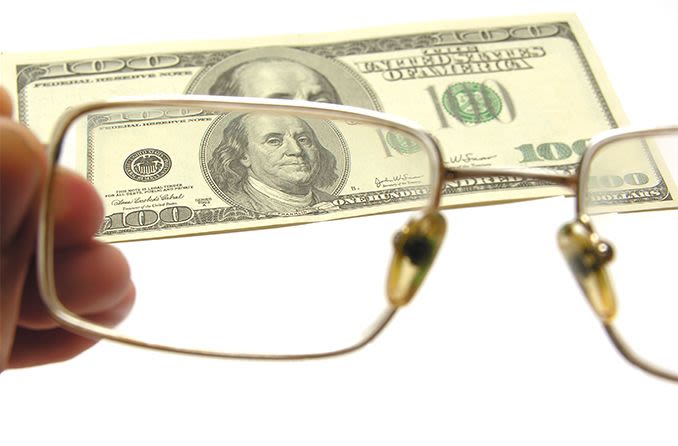Prescription eyeglasses: Why are they so expensive?

Why are some prescription glasses so expensive? Factors affecting the price of your new glasses include your prescription needs (lenses), your personal preferences (frames and lens coatings) and even where you purchase your eyewear.
Let’s take a look at some possible reasons your prescription specs are so pricey:
Where you buy your glasses affects price
Buying glasses from your eye doctor or a retail optical store offers a number of benefits (an eye care professional measuring your pupillary distance and an optician helping you select glasses, for example), but that personal attention also tends to cost more than shopping online.
Your vision prescription needs also should factor into your decision.
For example, if you need single-vision lenses, buying online is often cheaper and relatively risk-free. You may need to calculate your own pupillary distance and frame measurements, but if you're of a do-it-yourself frame of mind, you can save money buying your next pair of glasses online.
However, if you require progressive lenses or have a complex prescription, it’s generally best to purchase your glasses from your eye doctor to ensure you’re getting a quality pair that fit well and meet your needs.
READY TO SHOP FOR GLASSES? Find an optical store near you or shop online. Use the guide below to customize your glasses options.
Lens and frame options
The shape and style of eyeglass frames may be the first things you notice while shopping for new eyewear, but it’s important to consider other factors that can contribute to the longevity and cost of your new glasses.
According to the American Academy of Ophthalmology, quality frames should be “lightweight, strong, flexible and corrosion-resistant.” The group also suggests metal frames will likely have a longer life, whereas plastic frames tend to be cheaper and offer more in the way of “fashion options.”
Your choice of lens material (glasses, plastic, composite or other) also is a major factor in the cost of eyeglasses.
Glass lenses are still considered the highest quality, but they are also more expensive, heavier and a safety hazard in the event of a broken lens, plus they take longer to make and are not even an option with stronger prescriptions.
Plastic lenses, according to The Vision Council, are much lighter than glass lenses and widely prescribed for their comfort, durability and impact resistance. Plastic lenses also are more affordable, more durable and come in a range of options.
A scratch-resistant coating can be applied to plastic lenses to prevent unwanted scuffs and marks.
Other varieties of lenses:
HIGH-INDEX LENSES: If you require a stronger prescription, you will most likely need high-index lenses for a thinner, lighter fit with your frames. This lens material is more expensive than regular plastic, but they are becoming more affordable.
HIGH-DEFINITION LENSES: For a more complex prescription, you may also want to spring for high-definition lenses for better peripheral and sharper vision correction.
MULTIFOCAL LENSES: Bifocals or trifocals can also increase the cost of your new specs, sometimes doubling the final cost. Progressive (no-line) lenses are customized and require a much higher degree of expertise to suit your needs, not to mention a heftier price tag.
Lens customizations
After you and your eye care specialist decide on the proper lens material, you may decide to add protective coatings and other customizations to keep your eyes comfortable and protected (or to enhance a desired look).
Common lens treatments like anti-scratch and UV-blocking coatings normally aren’t too expensive. However, adding an anti-reflective (AR) or anti-fog coating can certainly drive up the price.
If you’re looking for lenses that kill more birds with one stone, so to speak, special coatings like AR and blue-light protection (to reduce digital eye strain) come strongly recommended for many but will also add an extra layer of cost.
Also, mirrored, tinted and gradient lenses aren’t just for sunglasses. It might increase the cost a little, but don’t be afraid to play around with the look of your new glasses.
Brand-name and designer frames
When those designer specs are calling your name, you may want to brace yourself before you glance at the sales tag.
Designer and brand-name frames will always cost a prettier penny than generic or lesser known brands. And while a better quality is certainly expected to match the name and associated cost, sometimes you’re simply shelling out excess cash for the name on the frame.
Check with your eye doctor (and online reviews) to ensure that your coveted style is well made, worth those dollar signs and well-suited to your unique wearing needs.
Can my vision insurance help cover the cost?
Depending on your coverage and copay, your vision insurance should be able to foot a good part of the bill for new prescription glasses.
Familiarize yourself with the specifics of your vision care benefits. Most basic packages will cover routine preventive eye exams as well as prescription glasses and/or contact lenses, and some comprehensive plans will even cover more specialized treatments like lens coatings.
Check your plan to verify what is eligible for reimbursement and/or what is covered.
Other ways to save on your prescription glasses include flexible spending accounts (FSAs), health savings accounts (HSAs). Use the money you've saved to pay for lens upgrades or fancy frames.
READY TO SHOP FOR GLASSES? Find an optical store near you or shop online.
Page published on Friday, January 31, 2020






